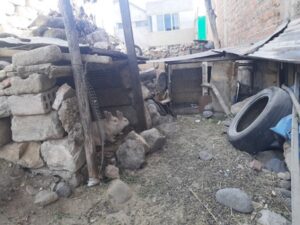
Chagas Disease and Triatomines – The Basics
Chagas Disease, primarily endemic to Latin America, is caused by the parasite Trypanosoma cruzi and affects an estimated 6-7 million people worldwide. Like other parasitic vector-borne diseases, there exists a delicate evolutionary balance between humans, the parasite, and the vector—in this case, triatomine bugs. Disrupting this balance through vector control remains the most effective strategy to prevent Chagas Disease, much like it has for malaria with mosquitoes and sleeping sickness with tsetse flies.
Triatomines undergo five nymph stages before becoming adults. During each life stage, they feed on a range of vertebrate hosts, including rodents, birds, and domesticated animals, thereby creating reservoirs for T. cruzi. Depending on their life stage, bugs consume between 2-12 times their body weight in blood, and to quote Charles Darwin, become “round and bloated”. It is their final antisocial act, however, which is most dangerous: these bugs defecate on their host. The faeces are highly infectious with T. cruzi and cause infection if rubbed into the eyes, bite site, or any open wound.
The control of Triatoma infestans has seen substantial success thanks to projects like the Southern Cone Initiative. Nonetheless, a decrease in the number of vectors gives rise to a new challenge – the difficulty of locating them. This difficulty has been particularly evident in Arequipa, Peru, so researchers are now testing an innovative bottom-up surveillance strategy to address this issue.

Triatoma infestans Surveillance – Empowering a Community Approach
To enable effective T. infestans surveillance, researchers introduced the AlertaChirimacha initiative, chirimacha being the local name for T. infestans. This community-centred approach, undertaken in collaboration with local health authorities, is designed to provide cost-effective outreach and ensure rapid responses to sightings of these insects.
A combination of technology and traditional methods (e.g., flyers) was employed to reach wider audiences in the community. Recognising the high usage of Facebook and WhatsApp in Arequipa, researchers used videos and targeted advertisements to educate residents on how to respond when they encountered T. infestans. Upon receiving reports of potential sightings (photographs or descriptions), the research team responded within 2-3 days. Residents were informed when the reported insect was not a triatomine, and if it was identified as a bedbug, received an information leaflet.
For confirmed sightings, a dedicated team was dispatched to the affected household within 7 days. The visit involved a thorough inspection and residual insecticide spraying of homes with confirmed T. infestans, while also conducting diagnostics for the presence of T. cruzi. Furthermore, positive households activated a more extensive outreach strategy, which included flyers and targeted Facebook ads set for a 1km radius. Additionally, neighbouring houses underwent inspections for T. infestans.
AlertaChirimacha – Results
AlertaChirimacha has been running for 26 months, of the 206 reports, 5.3% were T. infestans with 23% belonging to the similar-looking Vazquezitocoris sp. None of the insects identified were positive for T. cruzi. The system was successful in comparison to passive surveillance and active vector control surveillance, finding more infested households than the two methods together.
The reach of the Facebook posts grew from a small number of 2,528 to 60,028. The videos however had good reach with 59,287 views. When these Facebook ads were targeted because of neighbouring infestations this enabled researchers to find five infested households. Comments on Facebook posts were broadly supportive with residents providing their own experiences. Although the use of technology comes with misinformation and disinformation, this was luckily limited here; each post was addressed individually by researchers, and they was noted that these particular posts were not shared by other users.
All reported cases were responded to by three days with any positive houses inspected within a week. This resulted in 68 houses treated 20 of which had active infestations, the others as a preventative measure. In some cases, it was noted that householders had tried the traditional monitoring system and had no response therefore turned to AlertaChirimacha.

Final Thoughts
Previously, the system involved catching a suspected T. infestans (possibly infected) and taking it to the Health Authority, with the resident possibly being ignored. Instead, AlertaChirimacha creates a direct line from the community to the specialists. One issue with any kind of technological approach is that a portion of society could be at risk of being left behind, namely those that don’t have access. AlertaChirimacha tries to mitigate this by using flyers in shops and other areas. This work has been running for 26 months, so it will be interesting to see how this technological community-based approach evolves, what challenges they face, and how future programmes can learn from them.
I do not think the importance of community-based vector surveillance can be overstated, regardless of the vector. These programmes have education at their core, enabling populations to be actively involved in controlling the diseases which affect them.

Comments